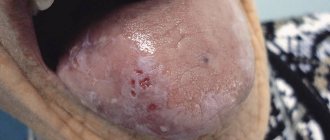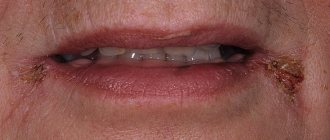Navigation:
- What to look for during a self-examination
- Choosing a specialist depending on symptoms
Today, a problem such as pathology of the oral mucosa is often diagnosed.
The disease can affect the lips, tongue, and cheeks. What to do? You need to go to the doctor! The dentist will provide assistance to the patient. If the disease is associated with therapeutic problems, you should visit a therapist. If necessary, narrow specialists will be invited for consultation. Note! For any abnormalities of the oral cavity and its organs, you should consult a doctor promptly. Ignoring the disease can lead to serious complications. The sooner the patient gets to the doctor, the faster and easier the therapy will be.
Many ailments of the chewing organs and oral cavity can be treated by a dentist. The tongue is a mirror of the body. His condition allows us to judge:
- About the work of the heart;
- Spleen and liver;
- Kidney, when the pathology is detected from the side;
- Stomach or pancreas;
- Teeth, gums;
Based on the nature of the patient’s complaints, plaque, color, smell, and tests, the doctor determines the problems that have arisen. It is important not to delay going to the medical center. When the disease concerns the chewing organs or mucous tissues of the mouth, you need to consult a dentist. Dentistry in St. Petersburg is a department where they will provide professional assistance to any patient. Diseases are often caused by bacterial, viral, fungal infections, and improper functioning of internal organs.
- Go to the dentist if the burning sensation bothers you, the problem is related to the gum tissues, teeth. Inflammation can be caused by a denture, periodontal disease, or an unsuccessful filling.
- Visit an ENT specialist to rule out tonsillitis and tonsillitis.
- For no apparent reason, make an appointment with a therapist. The doctor will determine the provoking factor and refer you to the right specialist.
This could be an endocrinologist, a neurologist, an infectious disease specialist and other doctors.
Treatment of diseases of the oral mucosa
To prescribe treatment, you must first establish the cause of the symptoms, as well as determine the degree of development of the disease.
Dentists can identify diseases in the first stages, which are asymptomatic. That is why it is very important to regularly visit a dentist so that if pathology develops, the cause can be eliminated without the development of complications.
Professional teeth cleaning is also important, because... this will keep your mouth healthy.
Sign up for a consultation with our highly qualified specialists from the Avalon clinic by phone number: +7 (931) 322-0-955. Clinic administrators will be happy to make an appointment, and dentists will answer all questions. Waiting for you!
The oral mucosa is constantly exposed to a variety of irritants - chemical, mechanical, thermal, numerous microbial agents and toxins. In addition, the oral cavity is a sensitive indicator, showing the state of the internal organs and promptly signaling the presence of problems in one or another body system. If at least one protective factor is weakened, there is a risk of developing inflammatory diseases of the oral mucosa. The most common of them are stomatitis and glossitis.
The cause of diseases of the oral mucosa can be: traumatic damage to the tissues of the oral cavity and other traumatic effects (chemical, thermal, etc.) with the development of traumatic erosion, ulcers, leukoplakia or leukokeratosis (keratinization of an area of the mucous membrane capable of malignant degeneration).
Infectious diseases that affect the oral mucosa due to the penetration of viruses, bacteria, and fungi. Quite often, the occurrence of pathological changes in the oral mucosa is associated with disruption of the functioning of various organs and systems of the body: allergies, dysfunction of the cardiovascular system, gastrointestinal tract, endocrine disorders, systemic connective tissue diseases, blood diseases, dermatoses, tuberculosis, AIDS and some other conditions. It is often quite difficult to identify the true cause of pathology of the oral mucosa - a lot of experience, high professionalism, and the ability not only to carefully collect information, but also to interpret it correctly and draw appropriate conclusions are required.
Dentists will quickly understand the manifestations of the disease in relation to a particular patient, determine the cause of the disorder and prescribe highly effective treatment.
MAIN CLINICAL MANIFESTATIONS
There is a common name for inflammatory diseases of the oral mucosa - stomatitis. When the pathological process is localized on the tongue, they talk about glossitis, on the gums - about gingivitis, on the lips - about cheilitis. When the mucous membrane of the mouth thickens, becomes horny and peels, they speak of a special type of disease - leukoplakia. A characteristic manifestation of stomatitis is the appearance on the oral mucosa of foci of redness, blisters, erosions (afts) or ulcers covered with plaque. These lesions are most often detected on the mucous membrane of the cheeks, floor of the mouth, hard palate, and tip of the tongue. Often there is pain at the location of erosions and ulcers, enlargement of nearby lymph nodes, and sometimes an increase in body temperature. The average duration of the disease is 7-14 days. Stomatitis can recur with decreased immunity, poor diet, hypovitaminosis, infectious diseases, and exacerbations are more common in spring and autumn.
DIAGNOSIS OF ORAL CAVITY DISEASES
Diagnosis of stomatitis and other diseases of the oral cavity is based on a thorough clinical examination of the patient by a dentist, which makes it possible to determine the stage of the pathological process and its prevalence, and the presence of a general reaction of the body to inflammation. It is very important to establish the true cause of the disease (trauma, infection, allergy, pathology of internal organs, hypovitaminosis, etc.), because the effectiveness of treatment and the absence of exacerbations in the future will depend on this.
PRINCIPLES OF TREATMENT OF DISEASES OF THE ORAL MUCOSA
Etiotropic and pathogenetic therapy aimed at eliminating the cause of the disease (antiviral, antibacterial therapy for the infectious nature of stomatitis, glossitis, cheilitis, vitamin therapy for hypovitaminosis, treatment of the underlying disease that caused the appearance of a pathological process on the oral mucosa); Local treatment aimed at eliminating local traumatic factors, the main symptoms of the disease and the rapid healing of existing erosions and ulcers; A general strengthening treatment that stimulates the body's defenses. An early visit to a dentist when identifying the first signs of pathology in the oral mucosa is the key to a speedy recovery!
STOMATITIS
Stomatitis is a general concept of inflammatory diseases of the oral mucosa. This pathology usually occurs against the background of a general and local decrease in immunity. Depending on the cause of occurrence, the following types of stomatitis are distinguished: • Chronic recurrent aphthous • Herpetic • Ulcerative-necrotic • Candidal
Chronic recurrent aphthous stomatitis - manifests itself in the form of characteristic painful aphthae on the mucous membrane of the lips, cheeks, palate or tongue. The main causative agents of this disease are viruses and bacteria. The disease manifests itself against the background of an imbalance in the body of vitamins such as B1 and B12. Most often this can be observed in chronic diseases of the liver and gastrointestinal tract (gastrointestinal tract).
Herpetic stomatitis
The causative agent of herpetic stomatitis is the common herpes virus. Herpetic stomatitis most often occurs in children aged 1 to 3 years. At the same time, in children, at the very beginning of the disease, general symptoms of intoxication begin to appear: • General malaise occurs • Body temperature rises • Lymph nodes enlarge • Nausea and vomiting • Diarrhea
Then, on the oral mucosa, as well as on the red border of the lips, peculiar bubbles begin to form, which quickly open and form erosions with characteristic so-called scalloped (uneven) edges. After about 8-10, healing occurs.
Necrotizing ulcerative stomatitis is characterized by necrosis of the gingival margin. More often, inflammation begins with the interdental papillae and adjacent mucous membrane, namely the cheeks. Then painful, easily bleeding ulcers form, which very quickly merge and form quite large defects in the mucous membrane. As a result of the active process of necrosis, a characteristic putrid odor occurs from the mouth. This picture can be observed with poor oral hygiene. This type of stomatitis is most common in adults aged 17 to 30 years. Necrotizing ulcerative stomatitis can be associated with diseases such as influenza, tonsillitis, acute respiratory infections, various blood diseases, AIDS, tuberculosis and give quite unpleasant and serious complications. In addition to rashes, with this pathology of the mucous membrane, general symptoms of intoxication are also noted - increased body temperature, general malaise, as well as enlarged and painful lymph nodes. Candidal stomatitis
Candidal stomatitis
Candidal stomatitis is a fairly common disease of the oral mucosa, caused by fungi of the genus Candida. In the oral cavity, the following manifestations are noted: • Dryness • Burning • Formation of a white cheesy coating (when this plaque is removed, the mucous membrane bleeds profusely)
Treatment of stomatitis
First of all, at the first symptoms of one or another type of stomatitis, you need to contact a dental clinic. In this case, you should not self-medicate! Indeed, depending on the type of disease, the doctor prescribes a specific treatment for stomatitis. Therefore, the main task of the dentist is, firstly, competent diagnosis, secondly, elimination of the cause of the disease, and only, thirdly, symptomatic therapy for the complete and final treatment of stomatitis. The main prevention is, of course, high-quality and regular individual oral hygiene and careful attention to your health.
Clinical manifestations of stomatitis According to clinical features, the following types of stomatitis are distinguished: catarrhal, ulcerative, aphthous.
Catarrhal stomatitis is the most common lesion of the oral mucosa. The cause of its occurrence is considered to be local factors: poor oral hygiene, dental disease, dental plaque, oral dysbacteriosis. Diseases of the gastrointestinal tract, such as gastritis, duodenitis, colitis, can also cause catarrhal stomatitis. The cause of catarrhal stomatitis may be helminthic infestation. With this disease, the oral mucosa becomes swollen, painful, hyperemic, and may be covered with a white or yellow coating. Hypersalivation (increased salivation) is noted. Bleeding gums and bad breath may occur.
How is catarrhal stomatitis treated?
Treatment comes down to eliminating local causes - removing tartar, treating dental diseases. The mucous membrane is treated with antiseptic rinses - 0.05% and 0.1% chlorhexidine solution. During the day, you can rinse your mouth with a warm solution of chamomile and calendula decoction. A gentle diet is required. With this treatment, the symptoms of stomatitis disappear after 5-10 days. If the symptoms of stomatitis do not disappear, then it is necessary to establish a common cause - as a rule, these are diseases of the gastrointestinal tract or helminthic infestation. In this case, local treatment should be combined with general treatment.
Ulcerative stomatitis is a more severe disease than catarrhal; it can develop either independently or be an advanced form of catarrhal. Most often, this disease develops in patients suffering from gastric ulcers or chronic enteritis. It also often occurs in patients with diseases of the cardiovascular system and blood, infectious diseases and poisoning. Unlike catarrhal stomatitis, which affects only the superficial layer of the mucous membrane, with ulcerative stomatitis the entire thickness of the mucous membrane is affected. The initial symptoms of catarrhal and ulcerative stomatitis are similar, but subsequently with ulcerative stomatitis there is an increase in temperature, weakness, headache, enlargement and tenderness of the lymph nodes. Eating is accompanied by severe pain. If such symptoms appear, you should consult a doctor.
Aphthous stomatitis is characterized by the appearance of single or multiple aphthae (ulcers) on the oral mucosa. Aphthae are oval or round in shape, no larger than a lentil grain, with clear boundaries in the form of a narrow red border and a grayish-yellow coating in the center. The causes of this variant of stomatitis are considered to be diseases of the gastrointestinal tract, allergic reactions, viral infections, and rheumatism. The disease begins with general malaise, increased body temperature, and the appearance of pain in the mouth at the site of aphthae formation. This disease should be treated by a doctor.
Leukoplakia is a chronic lesion of the oral mucosa, which is based on increased keratinization of the epithelium (hyperkeratosis). It affects mainly men after 40 years of age and is localized on the mucous membrane of the cheek, in the corners of the mouth and the lateral surfaces of the tongue. The causes of leukoplakia can be mechanical injuries to the mucous membrane: cuts from hooks from a denture, burns from hot or spicy food, etc. This disease most often does not have pronounced symptoms, only sometimes the patient may feel mild itching and burning. But the danger of the disease is that it can develop into malignant forms, so the patient needs to consult an oncologist.
GLOSSITIS is an inflammation of the tissues of the tongue. It can be superficial or deep. Most often, glossitis is a symptom of some general disease of the body, but it can also occur independently.
The main causes of glossitis are: carious teeth, difficult teething, tartar, injuries to the mucous membrane of the tongue and oral cavity, smoking, alcohol abuse, poor oral hygiene, poisoning with heavy metal salts, burns, too hot food, hot spices, allergic reactions etc. Superficial glossitis is often a sign of diseases of the gastrointestinal tract and infectious diseases. It is characterized by the presence of plaque on the tongue, its swelling, hardening, and limited mobility. The tongue becomes bright red, there is a burning sensation in the tongue, pain, loss of taste, and excessive salivation.
Treatment of superficial glossitis is based on the use of local anesthetics and anti-inflammatory drugs. For oral administration, multivitamins, desensitizing agents (antihistamines), and immunostimulants are prescribed. Oral debridement (the process of cleaning an open wound by removing foreign material and dead tissue from it so that nothing impedes its healing) is of great importance.
With deep glossitis, everything is much more complicated. The inflammatory process in this form of the disease is localized in the thickness of the tongue and manifests itself in the form of an abscess (a limited accumulation of pus that occurs during acute or chronic focal infection). Deep glossitis can spread to the floor of the mouth and cause inflammation in the chin and neck. For this form of glossitis, surgical treatment is indicated.
In addition to the above, there are also non-inflammatory forms of glossitis, namely:
— desquamative glossitis (geographical tongue) This form of the disease occurs during pregnancy, damage to the gastrointestinal tract, blood diseases, metabolic disorders, some infectious diseases, helminthic infestations, and rheumatism. Desquamative glossitis is characterized by focal destruction of the red epithelium on the back and lateral surfaces of the tongue. The alternation of lesions with restored and destroyed epithelium makes the surface of the tongue look like a geographical map. In addition to external changes, burning and pain in the tongue may occur. Therapy for desquamative glossitis is based on the treatment of the underlying disease that provoked the development of glossitis.
— rhomboid (median) glossitis Rhomboid glossitis is a congenital anomaly of the tongue as a result of disruption of fetal development processes.
- villous glossitis: this form of glossitis is characterized by the proliferation and keratinization of filiform papillae.
- folded glossitis: glossitis of this form is a congenital anomaly and is characterized by the formation of folds on the back of the tongue, the deepest of which runs longitudinally along the midline. Folded glossitis usually does not cause complaints and does not require treatment.
- Gunter's glossitis: this form of glossitis is one of the signs of anemia caused by a lack of vitamin B12 and folic acid. It is characterized by the absence of papillae and a smooth (varnished) surface of the tongue.
— interstitial glossitis: a similar form of glossitis develops with syphilis in the tertiary period. The tongue becomes denser, its mobility is limited.
villous glossitis geographic language Glossitis Prevention of glossitis includes: oral and dental hygiene, regular visits to the dentist, reducing the consumption of aggressive and spicy foods, avoiding smoking and alcohol abuse.
Treatment of diseases of the oral mucosa
The basis of treatment for diseases of the oral mucosa is the elimination of the causes that provoked them. The oral cavity is subject to sanitation, the sharp edges of the teeth are processed, and the denture is correctly adjusted. The patient is advised to stop smoking and eating spicy and hot foods.
Tartar in case of stomatitis is removed, and the teeth are subject to treatment. It is necessary to rinse the oral mucosa with antiseptic agents. Folk remedies are also used: infusions and decoctions of chamomile and calendula. If signs of stomatitis persist after 5-10 days, most likely their cause is a disease of the gastrointestinal tract or helminthic infestation. Then local treatment is combined with general treatment.
The dental clinic diagnoses and treats a wide range of diseases of the oral mucosa. These diseases are diverse, variable and often cause a lot of suffering to patients, despite the fact that they cannot be correctly diagnosed and treated correctly everywhere. In addition, diagnostics using the mucous membrane of the oral cavity and tongue helps to clarify the condition of internal organs and systems, which is important because it does not require additional complex laboratory methods.









